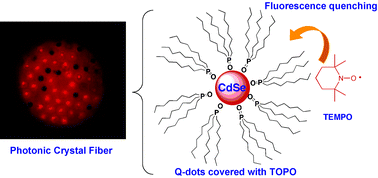The potential performance of Photonic Crystal Fibers (PCF) in the construction of microdevices, particularly sensors, has not been fully explored. One of the principal requirements for new PCF applications is the incorporation of additional functionality. We have explored the possibility of filling the PCF microchannels with liquids containing fluorescent probes such as coumarin 6 (C6) or nanocrystal semiconductors (CdSe quantum dots). Fluorescent probes can undergo significant changes in their emission properties in response to pH variations, or in the presence of other materials, such as paramagnetic species. In the case of quantum dots incorporated by capillarity in PCF channels an interesting size dependence of their luminescent properties on the presence of nitroxide radicals is reported. TEMPO (2,2,6,6-tetramethylpiperidine-N-oxide free radical) quenches the fluorescence of green quantum dots (2.4 nm) followed by spontaneous emission-recovery within minutes. However, for red quantum dots (6.7 nm) longer times are necessary to observe partial fluorescence recovery. This behavior agrees with a strong non-linearity of the quenching observed for the smaller quantum dots in solution compared to a closer-to-linear dependence for the bigger nanocrystals. In the case of 4-amino-TEMPO quenching occurs at much lower concentrations and fluorescence recovery is minimal. The mechanisms involved are discussed.

You have access to this article
 Please wait while we load your content...
Something went wrong. Try again?
Please wait while we load your content...
Something went wrong. Try again?


 Please wait while we load your content...
Please wait while we load your content...